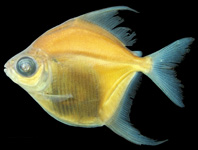Abstract
A new species of Myloplus Gill is described from Eastern Tumucumaque Mountain Range, drainages of the Oyapock and Araguari rivers between Brazil and French Guiana. The new species is diagnosed by having comparatively large scales on the flanks, resulting in lower counts when compared with congeners, i.e., 59 to 70 total perforated scales on lateral line, 31 to 35 longitudinal scales above lateral line, 24 to 29 longitudinal scales below lateral line, and 22 to 26 circumpeduncular scale rows. The new species most closely resembles Myloplus rubripinnis by sharing with this species a general rounded shape, a similar color pattern, and a high number of rays, i.e., 23 to 25 branched dorsal-fin rays and 35 to 38 branched anal-fin rays in the new species (vs. 24 to 25 and 32 to 40, respectively, in M. rubripinnis). After reviewing the available type-specimens of all Myloplus species, M. rubripinnis is re-diagnosed as having higher counts of branched dorsal-fin rays and anal-fin rays combined to tiny scales on flanks, i.e., 85 to 89 total perforated scales on lateral line, 38 to 45 longitudinal scales above lateral line, 33 to 42 longitudinal scales below lateral line, and 30 to 39 circumpeduncular scale rows.
References
Andrade, M.C., Jégu, M. & Giarrizzo, T. (2016) A new large species of Myloplus (Characiformes, Serrasalmidae) from the Rio Madeira basin, Brazil. Zookeys, 571, 153–167.
https://doi.org/10.3897/zookeys.571.5983Andrade, M.C., Ota, R.P., Bastos, D.A. & Jégu, M. (2016) A new large Myloplus Gill 1896 from rio Negro basin, Brazilian Amazon (Characiformes: Serrasalmidae). Zootaxa, 4205 (6), 571–580.
https://doi.org/10.11646/zootaxa.4205.6.5Eschmeyer, W.N., Fricke, R. & Van der Laan, R. (2017) Catalog of fishes: genera, species, references. Available from: http://researcharchive.calacademy.org/research/ichthyology/catalog/fishcatmain.asp (accessed 4 October 2017)
Irving, M. de A. (2004) Parque Nacional Montanhas de Tumucumaque (AP-Brasil): “ultraperiferia” ou “laboratório” para a cooperação em gestão da biodiversidade nos espaços amazônicos de fronteira? Revista de Desenvolvimento Econômico, 26–37.
Jégu, M. (2003) Subfamily Serrasalminae (Pacus and Piranhas). In: Reis, R.E., Kullander, S.O. & Ferraris, Jr., C.J. (Eds.), Check list of the freshwater fishes of South and Central America. Edipucrs, Porto Alegre, pp. 182–196.
Jégu, M., Hubert, N. & Belmont-Jégu, E. (2004) Réhabilitation de Myloplus asterias (Müller & Troschel, 1844), espèce-type de Myloplus Gill, 1896 et validation du genre Myloplus Gill (Characidae: Serrasalminae). Cybium, 28, 119–157.
Jégu, M., Keith, P. & Le Bail, P.Y. (2003) Myloplus planquettei sp. n. (Teleostei, Characidae), une nouvelle espèce de grand Serrasalminae phytophage du bouclier guyanais. Revue Suisse De Zoologie, 110, 833–853.
https://doi.org/10.5962/bhl.part.80216Lujan, N.K. & Armbruster, J.W. (2011) The Guiana Shield. In: Albert, J.S. & Reis, R.E. (Eds.), Historical Biogeography of Neotropical Freshwater Fishes. University of California Press, Berkeley, pp. 211–224.
https://doi.org/10.1525/california/9780520268685.003.0013Mattox, G.M.T., Britz, R. & Toledo-Piza, M. (2014) Skeletal development and ossification sequence of the characiform Salminus brasiliensis (Ostariophysi: Characidae). Ichthyological Exploration of Freshwaters, 25, 103–158.
Müller, J. & Troschel, F.H. (1844) Synopsis generum et specierum familiae Characinorum: prodomus descriptionis novorum generum et specierum. Archiv für Naturgeschichte, 10, 81–99.
Nico, L.G., Jégu, M. & Andrade, M.C. (2017) Family Serrasalmidae - Piranhas and Pacus. In: Van der Sleen, P. & Albert, J.S. (Eds.), Field Guide to the Fishes of the Amazon, Orinoco, and Guianas. Princeton University Press, Princeton, pp. 172–196.
Ortí, G., Sivasundar, A., Dietz, K. & Jégu, M. (2008) Phylogeny of the Serrasalmidae (Characiformes) based on mitochondrial DNA sequences. Genetics and Molecular Biology, 31, 343–351.
https://doi.org/10.1590/S1415-47572008000200030Sabaj, M.H. (2016) Standard symbolic codes for institutional resource collections in herpetology and ichthyology: an Online Reference. Version 6.5 (16 August 2016). American Society of Ichthyologists and Herpetologists, Washington, DC.Eletronically accessible. Available from: http://www.asih.org/ (accessed 26 February 2018)
Thompson, A.W., Betancur-R, R., López-Fernández, H. & Ortí, G. (2014) A time-calibrated, multi-locus phylogeny of piranhas and pacus (Characiformes: Serrasalmidae) and a comparison of species tree methods. Molecular Phylogenetics and Evolution, 81, 242–257.
https://doi.org/10.1016/j.ympev.2014.06.018Weitzman, S.H. (1962) The osteology of Brycon meeki, a generalized characid fish, with an osteological definition of the family. Stanford Ichthyological Bulletin, 8, 1–77.

